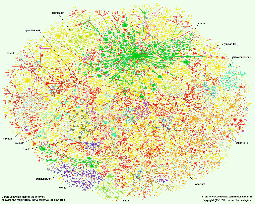Layout Showing the Major ISPs
Bill Cheswick, Bell Labs and Hal Burch, CMULucent Technologies Bell Labs Innovations
Carnegie Mellon University (CMU) Computer Science Dept.
URL: https://www.bell-labs.com/about/history/#gref
Frequent traceroute-style path probes are used to build a tree showing the paths to most of the nets on the Internet. Once the layout is computed, the map can be colored to show geographical clues, network capacity, or IP addresses. In this example, color distinguishes different ISPs.
| Visualization Thumbnail | Analysis | ||||
|---|---|---|---|---|---|
 |
|
||||
| Full-Size Visualization | Back to Gallery |


